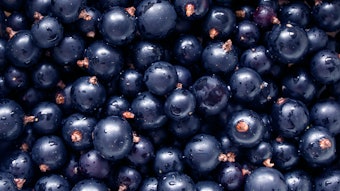
The author wishes to thank Silesia Flavors for their hospitality in graciously hosting this session.
Roasted Barley Extract 40%
Source: Biolandes
GRAS, CAS# 85251-64-5, natural, Hordeum vulgare L.
Odor: @ 100%. Sweet, brown, caramellic, cocoalike, woody and tobaccolike.
Taste: @ 0.02%. Sweet, brown, nutty and roasted.
Taste: @ 0.05%. Sweet, brown, grainlike, bready, nutty, roasted, and cocoalike.
Possible applications: The sweet, brown notes of this material will make it very useful in flavors of that ilk, especially caramel, peanut, walnut, maple, vanilla, chocolate, malt, cereal, bread, tobacco and coffee. Dried fruit flavors, like raisin, prune and fig, are also good considerations for its use, as are whiskey and beer.
Parsley Herb Oleoresin
Source: Lionel Hitchen
FEMA# 2837, CAS# 8025-95-4, natural
Odor: @ 100%. Green, herbal, fresh, parsley, terpeney, vegetablelike and slightly woody.
Taste: @ 5 ppm. Green, herbal, fresh, terpeney and vegetablelike.
Taste: @ 10 ppm. Green, herbal, fresh, parsley, terpeney and vegetablelike.
Possible applications: This material will enhance vegetable flavors, like green pepper, carrot, celery, and add interest to herbal blends for chicken soup, tomato sauce, meats and the like. Its terpeney, green notes will make it an interesting addition in tropical flavors, like mango, guava and kiwi.
2-Ethyl-4-hydroxy-5-methyl-3(2H)-furanone, natural (synonym – Homofuranone)
Source: Charkit
FEMA# 3623, CAS# 27538-10-9, natural
Natural occurrence: Blackberry, cheese, coffee, lovage and raspberry.
Odor: @ 100%. Sweet, brown, caramellic, burnt sugar and maplelike.
Taste: @ 5 ppm. Sweet, caramellic, brown and maplelike.
Taste: @ 10 ppm. Sweet, brown, caramellic, brown sugarlike and maplelike.
Possible applications: With its sweet, caramellic qualities this furanone will be well-used in brown flavors, like brown sugar, caramel, maple, chocolate, coffee, dulce de leche, butterscotch, honey and jam flavors. Whiskey, bourbon and rum flavors are also good uses for this material.
Nootkatone EU Natural (ex biotransformation)
Source: De Monchy Aromatics
FEMA# 3166, CAS# 4674-50-4, natural
Natural occurrence: Bergamot, blood orange, grapefruit, lemon, mandarin, orange, tangerine, valerian root and wormwood.
Odor: @ 100%. Terpeney, citruslike, grapefruitlike, woody and peely.
Taste: @ 5 ppm. Grapefruitlike, citruslike, peely and woody.
Taste: @ 10 ppm. Grapefruitlike, citruslike, woody and slightly oily.
Possible applications: Citrus flavors are the primary applications for this product, especially grapefruit where it will bring out lovely, juice notes. It will also enhance tropicals, like mango and passion fruit, as well as punches where it will add a mysterious twist.
Pyrazine Mixture III #1478, natural
Source: Advanced Biotech
FEMA# n/a, CAS# n/a, natural
Odor: @ 1%. Musty, nutty, earthy, slightly grainy, dirty and roasted.
Taste: @ 1 ppm. Musty, nutty, dirty, brown and slightly fungal.
Taste: @ 2 ppm. Nutty, roasted, musty and potato skinlike.
Possible applications: With the musty, nutty, roasted notes that are so appreciated in pyrazines, this particular mixture will find a home in many brown flavors, like peanut, baked potato, hazelnut, dark roasted coffee, chocolate, roasted grain and bread.
Oakmoss Absolute
Source: Biolandes
FEMA# 2795, CAS# 977059-15-6, natural, Evernia prunastri and other lichens species
Odor: @ 1%. Sweet, softly green, musty and slightly leatherlike with a hint of seaweed.
Taste: @ 1 ppm. Sweet, green, musky, slightly woody, dry and seaweedlike.
Taste: @ 2 ppm. Green, powdery, musty, woody and slightly leatherlike.
Possible applications: This wonderful material is neither tree nor moss, but rather a combination of fungus and algae, living in symbiotic harmony. Used primarily in fragrances, it can add another dimension to maple, seaweed, anise, mint, sweet herbal, root beer, liqueur and fantasy flavors.
p-Methoxybenzaldehyde, natural (synonym: p-anisaldehyde)
Source: Sigma-Aldrich
FEMA# 2670, CAS# 123-11-5, natural
Natural occurrence: Anise, basil, cassie, cinnamon, cranberry, black currant, tagetes and vanilla.
Odor: @ 1%. Sweet, powdery, anisic, cherrylike and floral with a hint of mothball.
Taste: @ 1 ppm. Sweet, vanillalike, slightly floral, cherrylike and aniselike.
Taste: @ 2 ppm. Sweet, cherrylike and aniselike.
Possible applications: At very low dosages this component will add a sweet brightness to vanilla, anise, sen sen, cherry, berry, licorice, tarragon, marshmallow, sweet herbal and mint flavors. It will also enliven carbonated beverage flavors, like cream soda, cola, root beer and sassafras.
2-Phenylpropanal propyleneglycol acetal (synonym: 4-methyl-2-(1-phenethyl)-1,3-dioxolane)
Source: DeLong Chemicals
FEMA# 4595, CAS# 67634-23-5
Not yet found in nature.
Odor: @ 1%. Earthy, mushroomlike, metallic and slightly vegetablelike with a whiff of honey.
Taste: @ 1 ppm. Mushroomlike, slightly cruciferous and earthy.
Taste: @ 2 ppm. Earthy, mushroomlike, green and slightly cruciferous.
Possible applications: The unusual combination of notes in this chemical will enhance the profiles of root vegetables, potato, mushroom, wasabi, bean sprout and crucifers, like cauliflower, cabbage and kohlrabi flavors. Since one of its synonyms is “melon acetal,” it will also be useful in melon flavors, especially cantaloupe.
5-methyl-2-phenyl-2-hexenal, mixture of isomers, natural
Source: Sigma-Aldrich
FEMA# 3199, CAS# 21834-92-4
Natural occurrence: Cocoa, malt, hazelnut, mate, peanut and potato chips.
Odor: @ 1%. Sweaty, dark chocolate, cocoalike, honeylike, slightly floral and warm.
Taste: @ 2 ppm. Cocoa powderlike and floral with a honeylike undertone.
Taste: @ 5 ppm. Dark chocolatelike and honeylike.
Possible applications: Chocolate flavors, especially dark and semi-sweet, are excellent applications for this material as are mocha, malt, honey, cocoa, peanut and hazelnut.
3-(Methylthio)hexyl acetate
Source: Charkit
FEMA# 3789, CAS# 51755-85-2
Natural occurrence: Muskmelon and passion fruit.
Odor: @ 1%. Green, sulfurous, tropical, savory, alliaceous and metallic.
Taste: @ 1 ppm. Fruity, green and tropical with onionlike and vegetable notes.
Taste: @ 2 ppm. Fruity, green and tropical with savory, onionlike, savory and meaty notes.
Possible applications: This ambidextrous ester with its fruity and savory profile will be very useful in tropical fruit flavors where sulfur notes are appreciated like guava, durian, pineapple, passion fruit, rambutan and lychee. It should also be helpful in bringing out the fresh character in green onion, garlic, leek, radish and wasabi.










